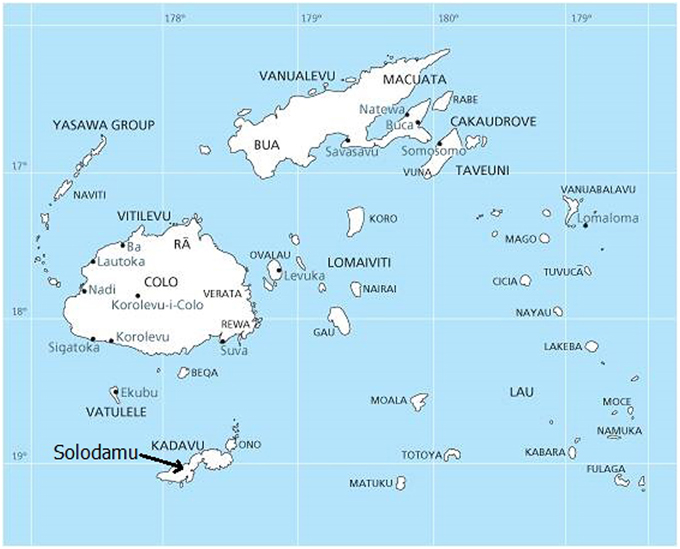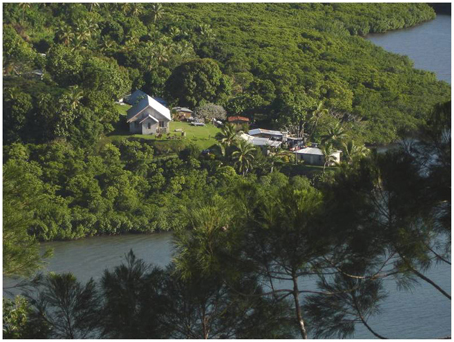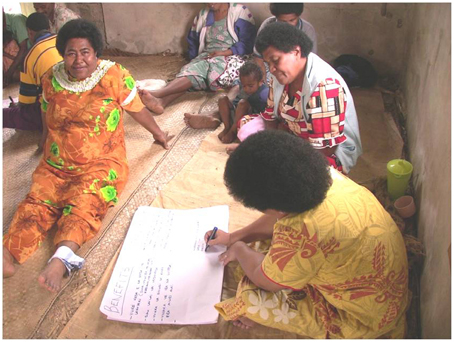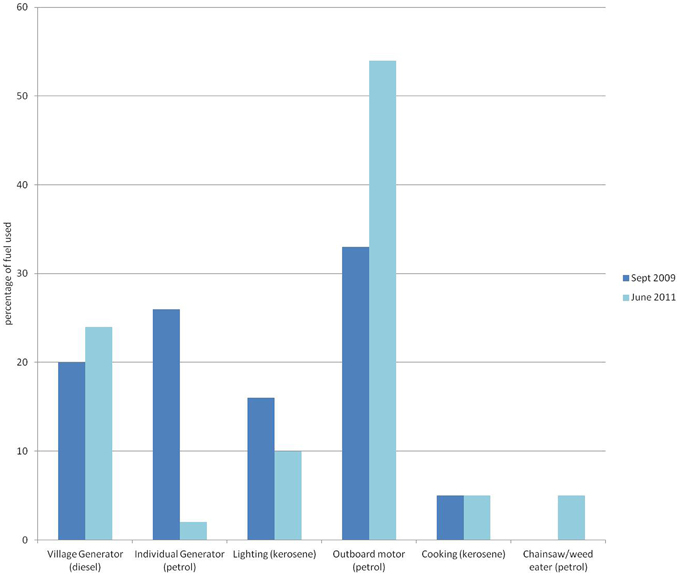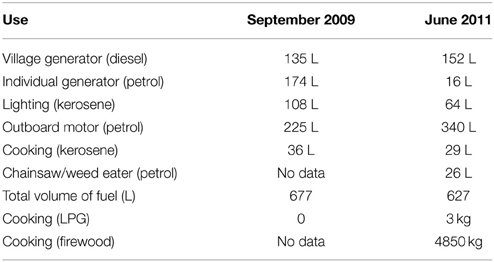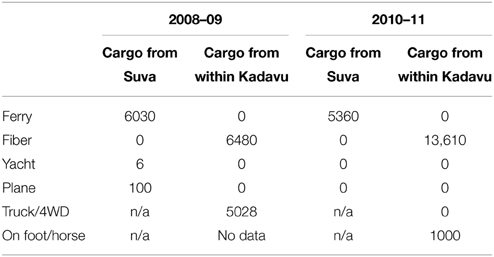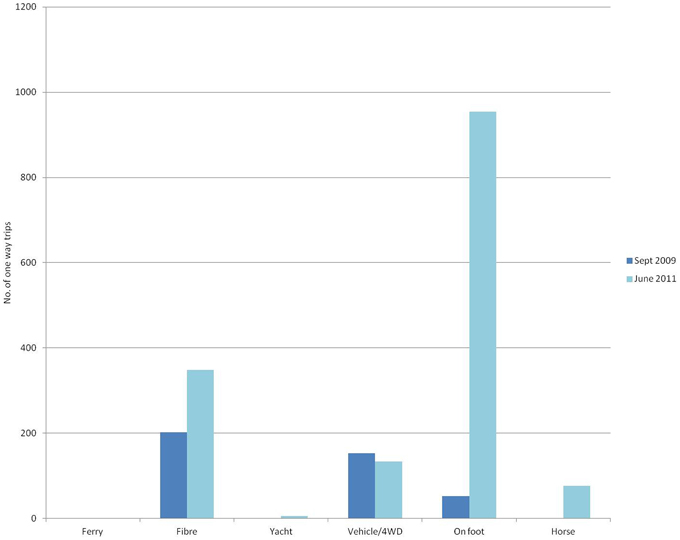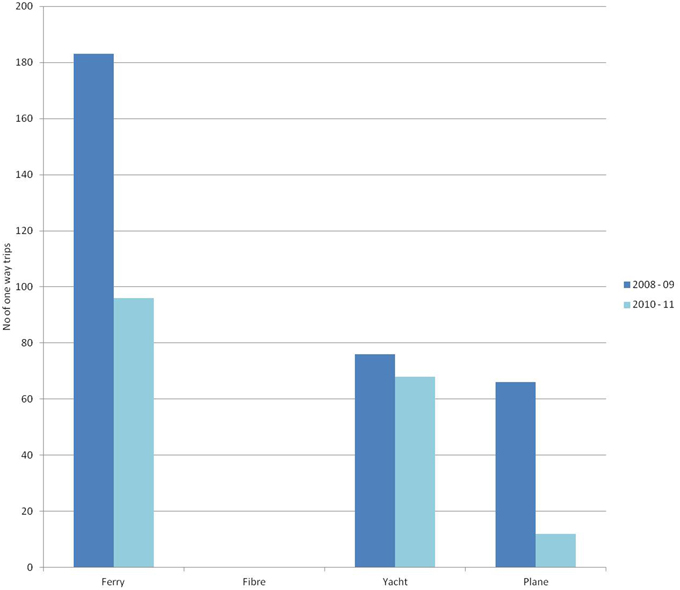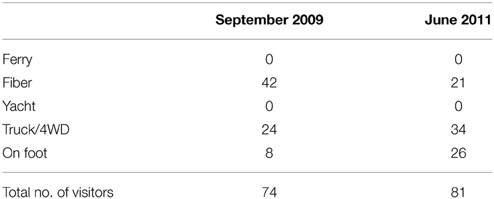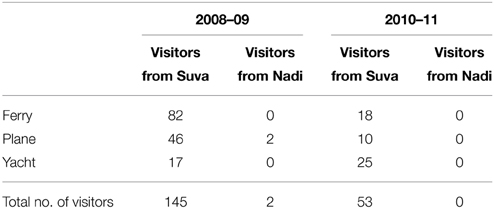The Solodamu Surveys: determining fossil fuel use and sea transport need in a coastal village in Fiji
- 1Pacific Centre for Environment and Sustainable Development, The University of the South Pacific, Suva, Fiji
- 2School of Marine Studies, The University of the South Pacific, Suva, Fiji
Domestic sea transport is critical to all aspects of life in the Pacific, providing access to markets and health and education services, as well as enabling cultural and social connectivity. Current sea transport services are entirely dependent upon use of increasingly expensive fossil fuels. Whilst there has been increasing research on international shipping, very little focus has been given to date to domestic shipping in the Pacific, and in particular at the local, village level. Recent studies have highlighted lack of data, particularly at a village level, as being a major impediment to progressing a shift to more sustainable transport. The importance of transport in achieving sustainable development and “green growth” is being increasingly highlighted by Pacific Leaders as a key priority, and particularly the need to find alternatives to reduce the region's crippling dependency on imported fossil fuels. Small Island Developing States (SIDS) in other regions also face similar challenges. This paper provides a summary of the findings of a village-based assessment of transport and fossil fuel use in Solodamu village, Kadavu, Fiji carried out in 2009 and 2011. The objectives of the surveys were to gauge the overall sea, land and air transport use by the village and the fossil fuel footprint of the village by collecting data on a household by household basis. We then go on to outline how this assessment methodology has been expanded for an island group and highlight the potential of using this in other SIDS, so building the data sets available for more accurate analysis of both transport need and fossil fuel use to better address the issues of fossil fuel dependency and sustainable transport for the Pacific.
Introduction
Transport is a priority for Pacific Forum Leaders under the Framework for Pacific Regionalism and its predecessor the Pacific Plan and its importance as a facilitator of economic growth is well recognized (ADB, 2007; UNESCAP, 2010; SPC, 2011; UNCTAD, 2014a,b,c). Sea-transport is essential at all levels of society from fishing and the local transport needs of small isolated islands and villages to inter-regional shipping needs of nation states. Providing efficient, sufficient, safe and reliable domestic shipping is one of the most trying challenges for Pacific Island Countries. The need for sustainable transportation and mobility to enable sustainable development was also highlighted by Pacific leaders at the Third International Conference of Small Islands Developing States in Samoa in September 2014 (United Nations, 2014).
Currently all maritime transport services are fossil-fuel powered and are becoming increasingly unsustainable as operational costs and the costs of fossil fuels increase. Despite recent reductions in fuel costs, the international shipping industry and researchers continue to predict that fuel costs will increase over time (see, for example Lloyds Register, 2015). Fijians are a highly mobile people; maintaining family connections is a vital concern and there is considerable travel between kin throughout Fiji. Any increase in transport costs immediately impacts maintenance of social and cultural connectivity as well as economic development.
The literature is thin and, historical analysis aside (Couper, 1968, 1973, 2009; Bayliss-Smith et al., 1988; D'Arcy, 2006, 2008), restricted largely to a few development agency reports. All agree however, that it is the intra-country domestic services that are in most dire need (AusAID, 2008; UNESCAP, 2010; SPC, 2011). Generally such shipping services are restricted to an aging and inefficient fleet. The marginal returns, especially for domestic services, means most operators are trapped in a cycle of replacing old ships with old ships or waiting for donated (and sometimes inappropriate) vessels.
Inter-island and coastal shipping services in the Pacific are usually run by governments or small, independent shipping companies. Many routes are commercially unviable and some are simply uneconomic. Governments are required to subsidize or otherwise provide for these with continually accumulating costs. SPC (2011) and UNCTAD (2014a) summarize that large distances, high fuel costs and low economies of scale make the cost of developing and maintaining transport infrastructure relatively high. Issues of constricted markets for local products and reliance on international trade are exacerbated by global developments as well as resulting in fewer employment and livelihood possibilities.
Because the vast bulk of commodities and manufactured goods are transported by ship in the Pacific, and considerable domestic travel is by sea, the cost and quality of shipping immediately affects the welfare of the consumers and producers (SPC, 2011). Additionally, the marginal nature of the industry means that financing shipping investment, either for governments or private operators, is problematic (ADB, 2007; SPC, 2011; UNCTAD, 2014c).
Generally, on outer islands, commercial or other economic activities are notably limited. The historical absence of commercial development within the outer lying islands has meant high biodiversity and cultural values have been preserved in most island communities. There are a number of existing initiatives with a common aim of building resilience or “climate proofing” the local communities and their island environments. These projects are focused on assisting and supporting local communities to maintain well-being through improved reliance on local and natural assets (Veitayaki et al., 2003). It is logical to add analysis of sea transport options to this portfolio of social, economic and environmentally focused initiatives (Prasad et al., 2013).
That sustainable transport is essential to developing “blue/green economies” is also becoming increasingly recognized. The outcomes from the 2013 inaugural meeting of the Pacific Islands Development Forum include: “Sustainable transport: We prioritize alternatives to existing petroleum driven land and sea transportation that significantly reduce fuel imports. Sustainable shipping approaches are to be promoted and adopted as an alternative to provide effective services for remote island communities” (PIDF, 2013). One of Fiji's Green Growth Framework's guiding principles is the reduction in carbon footprints and the Framework notes that for Fiji “transport remains one of the highest contributors toward carbon dioxide emissions—these amount to around 729 Gg (approximately 47% of Fiji's total annual carbon dioxide emission)” (Ministry of Strategic Planning, National Development and Statistics, 2014, p. 83).
There is no reliable data to calculate what percentage of fossil fuel use is attributable to sea transport but Mayhew (2011) considers it could be as high as 75% of all fuel used for some PICs. Whilst there has been significant effort by Pacific countries to reduce fossil fuel used for electricity generation in recent years, there has been little focus to date on the transport sector which uses significantly more fuel (Nuttall et al., 2013; Prasad et al., 2013). Using Fiji as an example, total petroleum imports “grew from around FJ$400 million [US$192 million1] in 2004 to a little over FJ$1.2 billion [US$0.57 billion] in 2013 which is approximately one third of Fiji's total import bill” (Ministry of Strategic Planning, National Development and Statistics, 2014, p.74) and of this 64% is used for transport compared to 19% for electricity generation (Economic Consulting Associates Ltd SMEC, 2013).
ADB (2013) provide an overview of regional energy demand and projections from 2010 to 2035, and note for Fiji that “With no domestic production, all the country's petroleum needs will rely on import. Given Fiji's high reliance on oil for its energy needs, the country is highly vulnerable to international oil price fluctuations” (p. 220). They go on to note that “oil is the only fuel consumed in the transport sector. Demand for oil for transport will increase at a moderate rate of 1.0% per year over the projection period” (p. 221) and that the transport sector is the main consumer of oil (p. 225). Again the ADB (2013) report has no information on sea transport fuel use, with the focus of analysis for transport being on land transport, reflecting the lack of data on fuel used by shipping in the region. ADB also predict the cost of crude oil imports to increase to US$110 (FJ$231)/barrel by 2020 and to US$135(FJ$284)/barrel by 2035 (p. 7). This has significant implications for domestic sea transport around and between the islands of Fiji, and the wider Pacific, for both trade of goods and for passenger mobility, as well as on tourism and fisheries which are key income generating sectors.
Recent research (Nuttall et al., 2013; Prasad et al., 2013) has highlighted the need for more data to support research and analysis into the fossil fuel used by the maritime transport sector in the Pacific. This is mirrored by the Fiji Government: “It is simply not possible to effectively manage what is not accurately measured. It will therefore be vital that the processes for the compilation and analysis of data, to support informed decision-making, are strengthened” (Ministry of Strategic Planning, National Development and Statistics, 2014, p. 23).
This paper is offered as a contribution, giving insight into how much fossil fuel is used annually by one small coastal village in Fiji, and of that what proportion is used for maritime transport. We then look at how this is being extended in Fiji to an island group level and the potential for use of this methodology in other Small Island Developing States (SIDS).
Methodology
The following section outlines the background to this village level assessment and, perhaps more importantly, why and how the surveys were undertaken. The key driver in undertaking the assessment was the desire of the villagers themselves to better plan for their future and to identify sustainable solutions, the research therefore being driven by the community itself supported by outside assistance.
Survey Location: Solodamu Village, Kadavu
Solodamu is a small village on the north-western coast of Kadavu, approximately 60 nautical miles (110 km) from Suva the capital of Fiji located on the main island of Viti Levu (see Figure 1). Solodamu is approximately 6 km to the west of Vunisea, the nearest town with a small hospital, post office, government offices, market, schools, jetty and airstrip.
The 2007 census showed Kadavu had a population of approximately 10,000 residents, all whom were iTaukei (indigenous Fijians) except for eight Indo-Fijians, residing in 75 villages and one small town, Vunisea (Fiji Islands Bureau of Statistics, 2010). Solodamu has 22 households and is the second smallest of six villages in Tavuki Bay that form the Tavuki tikina (a grouping of villages) with a population of around 120 people (this fluctuates regularly as individuals leave to pursue employment or education or return when opportunities for employment are not forthcoming).
There is one village store and no permanent industry or business, and the village relies primarily on subsistence farming, fishing, and yaqona (kava) for the Suva market (see Figure 2). Yaqona is the primary cash export for which the island is famous. Whilst no information was collected on household income during these surveys, Sofer (2007) noted that the average annual household cash income for Nalotu (a similar-sized village to Solodamu) was FJ$3014 (US$1435), 42.3% of which came from yaqona sales.
Existing Transport Services
Vunisea is comparatively well-serviced by air and sea transport with flights to both Suva and Nadi on small twin engine aircraft and twice-weekly roll-on/roll-off ferries to Suva. Transport from Vunisea to Viti Levu costs FJ$170–490 (US$81–233) one-way via plane and FJ$35–55 (US$17–26) one-way on the ferries. Although Kadavu is relatively well serviced when compared with other islands and communities in Fiji, Sofer (1985, 2007) highlights the vicious circle caused by marginal returns for shipping operators who service Kadavu resulting in ship operators being unwilling to service the route and the lack of sea transport services resulting in local communities not growing excess crops and other products for market.
Solodamu villagers travel to Vunisea over a “dry weather” road on foot (a 1½-2 h walk), by horse or by 4WD vehicle (a 30 min drive costing FJ$50 (US$23.8) for the vehicle one way) or by sea using “fibers” (small, 23–36 ft open skiffs or longboats, usually of made of wood or fiberglass and powered by an outboard engine of typically 40 or 60 horsepower) also a 30 min trip costing FJ$50 (US$23.8) per fiber one way. At the times the surveys were undertaken no vehicles were owned or stationed in the village and three households owned fibers. Fibers have been known to travel from Kadavu to the mainland but this voyage is hazardous and is only likely to be attempted in favorable weather or when prompted by high cultural need (e.g., to attend important funerals).
Survey Need
In 2008 the village population was dropping, with a predominance of elderly and single males and a falling school role due to villagers migrating to Suva for education and employment opportunities. The village sought assistance to investigate opportunities for employment to attract young families back to the village.
In order to identify potential opportunities, first the village looked back to what they had done in the past. The Youth Committee had successfully run a motor launch that they chartered around Kadavu, built with help from the Methodist Church. Due to management issues the launch ended up rotting on the beach due to lack of maintenance. Despite this the village was keen to further investigate sea transport as a potential income earner and employment opportunity and held several workshops to discuss whether a new village boat was an option.
In answering whether it would be feasible and viable, data on the village's transport demand was needed, in particular:
• How much cargo needs to be moved and to where?
• How many passengers?
• How often?
As the village's launch had been fossil fuel powered, and the costs of fuel were increasing, the village also wanted to know if renewable energy powered vessels were an option, and so wanted data on fuel use for the village.
An internet search was undertaken to see if there was any information that would assist and found nothing that was useful. Without data, decisions as to the type of boat that would be most appropriate become guesswork. Therefore the only option was to collect data as a priority.
Survey Methodology
The research need and process was identified by a working party (of both villagers and international volunteers) set up by the village chief. The objective was to gauge the current overall sea, land, and air transport use by the village and the fossil fuel footprint of the village by collecting data on a household by household basis and aggregating the totals. The research need and process were discussed with and agreed to by the village at their regular monthly meetings (see Figure 3). A questionnaire template was designed and agreed by the working party.
In September 2009 structured questionnaires were conducted in all 22 households and the survey was repeated in June 2011. Most interviews were conducted with a number of household members present, in all cases including at least the mother of the house. Invariably the interview process included tea and food and was open ended in terms of time taken. Participants were advised that the only information to be made available to others was overall village totals and not individual household data. Data collected was entered into a pre-prepared spreadsheet on a laptop during the surveys.
Individual household surveys collected detailed data on passenger and cargo transport to and from Solodamu (both within Kadavu and beyond) and fossil fuel use. Data was collected on types of cargo transported in the past month and in the last 12 months (e.g., hardware, produce or other), where it came from or where it was transported to, and how it was transported (e.g., by ferry, plane, yacht, fiber for cargo transported to other island destinations; and whether by fiber, vehicle/4WD, horse, ferry, or on foot for destinations within Kadavu). Passenger demand was determined by asking how many one-way trips the household had made and how many visitors they had had in the past month and in the last 12 months to or from other destinations within Kadavu and beyond, and the means of travel. Data was collected on volumes of fuel used for all uses (community owned diesel generator, individual household petrol generators, petrol for outboard motors and weed eaters/chainsaws, kerosene for cooking and lighting, and LPG for cooking). In 2011 data was also collected on firewood use for cooking and transport to and from the local schools and the villagers' farms/gardens.
The surveys were undertaken by a team of village researchers paired with international volunteers sanctioned by the village and conducted in both Fijian and English. The data was then analyzed and presented as a report to the village. The timing of the surveys (June and September) was based on availability of international volunteers.
The methodology of the survey when undertaken in 2009 and 2011 was not subject to any consideration or ethics approval process beyond that of the approval given by the village through its village meeting processes. The methodology subsequently adopted for a Master's research thesis based on an island group in Fiji which is also discussed in this paper was considered and approved by the University of the South Pacific's Faculty of Science, Technology and Environment Research Committee based on the University Ethics Committee's policies and guidelines.
Results
Fuel Use
As Figure 4 shows, the largest single user of fossil fuel was sea transport (outboard motors) and increased over time as a proportion of the total fuel used by the village (rising from 33% in 2009 to 54% in 2011). This is despite the number of households running outboards having reduced from 3 in 2009 to only 1 household in 2011.
A small amount of solar use aside, all electricity was fossil fuel derived, diesel for the communal generator and pre-mix for household generators (26% of fuel used was for electricity generation in 2011 having dropped from 46% in 2009). As a result of 5 years planning and fund raising by the village, the village had installed a communal diesel generator in 2009 that supplies reticulated electricity to all houses at a weekly cost of FJ$4 (US$1.9) per household. In 2009 the village generator ran for 3 h each evening, but this had dropped to 2 h in 2011, the increasing cost of the fuel being given as the reason for this. The electricity is for basic household use only and is primarily used for lighting, being insufficient to allow use of appliances such as refrigerators and washing machines.
In 2009 the village reported that the number of private generators had been increasing steadily to power electrical appliances (stereos, televisions, mobile phones, power tools, a few washing machines and at least one chest freezer). Interestingly there was a rapid decrease in fuel used for individual household generators from 26% of all fuel used in 2009 to 2% in 2011 as fewer households were using individual generators (only 2 households ran individual generators in 2011 compared to 10 households in 2009), the cost of the fuel again being given as the reason. More households were using rechargeable solar lamps and torches in 2011.
The volumes of fossil fuel consumed in 1 month in the village are shown in Table 1 below:
Other fuel used included kerosene for both lighting and cooking, petrol for chainsaws/weed eaters, and LPG by one household for cooking, with firewood remaining the primary fuel for cooking (households used on average ½ton of firewood/month/household).
Transport Demand
Transportation of both people and goods, both within Kadavu and between Kadavu and Viti Levu's transport hubs of Suva and Nadi, was assessed with data on volumes and types of cargo and numbers of passengers (both villagers and visitors) and mode of transport being collected. Monthly as well as annual figures were collected to determine seasonal variation.
Cargo
Between 2009 and 2011 there was an increase in goods (food crops and yaqona) transported from Solodamu to both Suva and elsewhere on Kadavu (see Table 2). Significantly how these cargos were transported within Kadavu changed from being by both sea and road in 2009 to all by sea in 2011 (38% of cargo being transported by fiber and 61% by 4WD in 2009 to 100% by fiber in 2011). The majority of cargo sent to Suva went on the ferry. Plane was infrequently used to export cargo, and a small amount was moved by yacht.
The quantities of cargo transported to the village (see Table 3) (of which more than 85% was hardware/building supplies and clothing, with 10% being household groceries) did not change significantly. Nearly all goods were brought by ferry from Suva. A similar change in transport mode was noticed for goods imported from elsewhere on Kadavu (56% of goods were transported to the village by sea and 43% by land in 2009 rising to 93% by sea in 2011). No cargo was imported from Nadi.
Passengers
The number of trips made by villagers within Kadavu increased (reflecting the inclusion of trips to their farms and/or school in the 2011 survey) (see Figure 5). Interestingly, no one used ferries for transport within Kadavu, despite the ferries calling at both Vunisea and Kavala (the other ferry jetty at the eastern end of the island). The data shows an increase in fiber use for passenger transport and decrease in use of 4WD, similar to that for cargo transport.
The number of trips made by villagers beyond Kadavu declined (see Figure 6), although ferries remained the primary form of transport (57% in 2009 and 54% in 2011). Figures of plane use to/from Suva are significantly affected by one individual who flew to/from Suva frequently for work purposes, with planes rarely being used by villagers. Solodamu has been regularly visited by a small number of yachts in the past 10 years and villagers have made increasing use of these for transport to and from Suva.
Despite fibers being capable of making the trip from Kadavu to Suva, no-one used fibers for transport from beyond Kadavu. This is probably due to the cost of the fuel, the length of the trip and the fact that is essentially a blue-water passage that should only be undertaken during extremely fine weather. Overall there has been a significant decrease in the number of trips made by Solodamu villagers to locations beyond Kadavu.
The number of visitors to Solodamu from elsewhere on Kadavu per month (see Table 4) did not change significantly, although the surveys showed that more used fibers or walked. Again the ferry was not used by visitors from elsewhere on Kadavu.
The data shows a significant drop in number of visitors to Solodamu from beyond Kadavu (see Table 5). Interestingly, there was an increase in visitors arriving by yacht, which means that even fewer visitors came to Solodamu by more “conventional” means. Visitors using ferry and plane decreased between 2009 and 2011 and no visitors used fibers.
Survey Limitations
The survey has only been carried out twice, although it is intended to repeat the exercise in the future. It therefore has no real baseline against which to show changes in annual trend. The survey gives data for the months of September and June. It does not therefore give a full picture of seasonal variation. Inter-island travel is known to have marked seasonal variation with the Christmas period and national events (especially during the Hibiscus Festival and Diwali when there are large sales in Suva, and the annual Methodist conference) being key drivers of increased transport use.
Figures of plane use to/from Suva are significantly affected by one individual who flies to/from Suva frequently for work purposes. Villagers have made increasing use of visiting yachts for transport of people and/or goods to and from Suva and it is not known to what degree this has skewed “normal” village movement patterns.
Not everyone in the village was interviewed. However, all households were canvassed and sufficient spread of village members was surveyed to suggest a high degree of accuracy in the final results. It provides a baseline for future surveys to determine trend over time.
The fuel use figures do not include the fuel used by the ferries for sea transport from Vunisea to Suva. Nor do these figures include fuel used for air or land transport so the total fuel used for transport is likely to be significantly higher than recorded.
Taking the Survey from Village to Island Group
In spite of the importance of domestic shipping to Pacific Island Countries, there has been almost no research or program to collect the necessary data for analysis at a village level. Recent work on profiling village transport need and fossil fuel footprints has been non-existent except for the surveys in Solodamu discussed above.
In 2013 the University of the South Pacific launched a new research program, the Sustainable Sea Transport Research Programme (SSTRP), designed to initiate long-term investigation and analysis of the potential for using renewable energy technologies for sea transport for the region (Nuttall et al., 2013; Prasad et al., 2013). Sustainable sea transport is an emerging and growing research field globally; however it has not been visible in the regional sustainability research agenda since the end of the oil crisis in the mid-1980's. Increasing concern over the region's fossil fuel dependency, the search for low carbon futures and the crucial role of sea transport to most aspects of economic, social and cultural wellbeing make the establishment of such a research agenda a logical priority.
As part of the above research program, the Solodamu village survey has been adapted as part of a current Master's thesis to assess the local transport needs of the Southern Lomaiviti in Fiji to gather much needed data for the country's transport sector.
The Southern Lomaiviti case study builds on the village survey of Solodamu and widens its scope to determine the current transport need of a group of islands and the options available to those communities for their future sustainable transport. As with the Solodamu survey work, the Southern Lomaiviti study aims to establish the sea transport demand and fuel use of the islands of Gau, Batiki, and Nairai, to inform comparisons of the current and alternative sea transport options. Household surveys of transport and fuel use have been developed from the Solodamu template as a starting point to allow comparison between Kadavu and Southern Lomaiviti. Drawing from the survey data, evaluation of transport use and expenditure for transport and fuel is being determined.
Further to gathering data on household fuel use, a census of fibers is being conducted for the three islands with up to 10 representative fiber operators filling out logbooks over a 6 week period to determine fuel and transport usage by the overall village community. Averaging of these and extrapolation using the fiber census data will allow a profile of small-scale vessel use for the three islands and establish fossil fuel use by sector for the islands. Additionally, by gauging the views of key stakeholders through face to face interviews, including village (e.g., Turaga-ni-Koro the village spokesman), industry (e.g., shipping operators), and government (e.g., Lomaiviti Provincial Council and Department of Transport), the information affords a more holistic view of the country's transport profile. To the best of our knowledge, this is the first time that structured field research of this nature has been attempted in Fiji or the Pacific.
An initial baseline assessment was conducted in July 2013 to gauge the current transport demand for representative villages on Gau Island. Throughout the five villages surveyed, it was found that the main mode of transportation is fiber, whether to Suva or around the island. Fibers are the primary source of travel because of the ill-maintained road on the island, infrequent air services and irregular ferry services. It is well understood by the locals that this is a risky mode of travel, but it is the only dependable means to move goods and people. There are regular media reports of fibers breaking down, running out of fuel or being lost at sea. This all too familiar picture is replicated in many outer lying islands in the country. In 2014, household surveys were undertaken in representative villages on Gau, Batiki, and Nairai and the data is currently being analyzed along with the fiber operator log books and stakeholder feedback.
Discussion
Inter-island transport is critical for Solodamu. Combined with coastal movements, it makes sea-transport crucial to every aspect of village well-being. It is essential for transport of both people and goods and is currently the single largest user of fossil fuel in Solodamu and is increasing (54% of fossil fuel used in 2011 rising from 33% in 2009). The increase in fuel used was primarily attributable to increased use of fibers for sea transport.
Electricity demand had increased up until 2009 but declined by 2011 this being attributable to the decline in use of individual household generators as the cost of fuel increased. A small amount of solar use aside, all electricity is fossil fuel derived. Firewood is the principal source of fuel used for cooking.
Fossil fuel is an increasingly expensive commodity. After a period of relatively stable prices, the cost of pre-mixed petrol (50:1 oil/petrol mix suitable for outboard motors) increased during the 2008 world oil price hikes to over FJ$3 (US$1.44) a liter in the village for a period. These prices have fluctuated since this extreme and at the time of the surveys was retailing in the village at around FJ$2.50 (US$1.2) a liter. Villagers also reported that it is an increasingly used commodity.
Interestingly, the Fiji Government operates a “shipping franchise” scheme whereby the Government subsidizes the costs of the ferry operators in order to ensure that “uneconomic” routes such as between Suva and Gau or southern Kadavu are serviced. Some FJ$1.725 million (US$0.83 million) was budgeted for subsidizing the inter-island ferries in 2014 (Naisara, 2014). This scheme covers the larger ferries, but not the local fiber operators. Villagers in the southern villages on Gau reported that they spent up to FJ$700 (US$335) per fiber trip from their village to the jetty where the ferry calls at the north of the island [with a fiber taking up to 10 passengers plus cargo i.e., FJ$70 (US$33.5) per passenger] compared to the government-subsidized trip from the jetty to Suva being FJ$55 (US$26) per passenger.
Assuming that Solodamu comprises around 1% of Kadavu's overall population then by extrapolation of the Solodamu average monthly fuel use data we calculate the island as a whole consumes on average more than 245 tonnes of fuel/year for sea transport using outboard motor driven fibers, at a cost of more than FJ$840,000 (US$402,444) if the cost is FJ$2.50 (US$1.2)/l which it was at the time of the surveys.
Globally, ships are becoming ever more energy efficient (with ever larger vessels and new technologies). International emissions regulations are one of the key drivers for the current revolution in shipping designs and operations. Unfortunately for the Pacific, these new vessel designs and technologies are not likely to reach our shores for decades, if at all.
Driven by need, communities in the Pacific are increasingly seeking to improve their access to regular sea transport themselves; see for example the community-driven small-scale sail-powered freighter “Vaka Fanaua” project in the Nuia island group in Tonga (https://www.facebook.com/vakafanauaaotearoa) and the community-owned MV Uluinabukelevu operating to southern Kadavu, Fiji (Fiji Times, 2014). There are numerous designs and vessels available from mono-hulls to fast catamarans and trimarans, many of which make use of renewable energy for propulsion. But what boat to choose and should alternatives to fossil fuel be considered? Before making any decisions as to what vessel to choose or the type of propulsion, the communities need to have good data on their current sea transport needs and costs, and this survey is one tool that can assist in providing that information. For example, if the need is for small volumes of cargo but more passengers and within sheltered waters a different vessel would be appropriate than if the need is for mostly cargo and blue-water passages. Depending on the cost of fuel for operating that vessel over its lifetime, then it may be worth considering alternatives such as renewable energy, and these decisions are best made before purchase of the vessel and with adequate information on need and existing transport costs.
Building the Baseline of Data
Adapting the village-based survey to island/national level determines whether the methodology is replicable in other locations or scenarios. This is an integral “missing link” in setting the baseline for transport and fuel data. Almost all attention on new technologies for sustainable sea transport internationally has focused on large-scale, new generation shipping primarily servicing the international routes. Such technologies have, to date, focused little attention in the development of alternative energy solutions for the Pacific. All sources agree that the priority for Pacific shipping lies on the domestic front. The Kadavu and Southern Lomaiviti case studies begin to provide, for the first time, reliable data on village-level transport use and need, and fuel consumption in order to start addressing this priority.
A key outcome is development of survey tools that are replicable for other Fijian communities and the wider Pacific region. We are encouraged to hear that our survey template has now been replicated on Jaluit Atoll, Republic of the Marshall Islands and we look forward to hearing of their findings.
The survey template could also be adapted for future work to look at the impact of inter-regional (between PICs) and international shipping and trade. The survey questionnaire could be expanded to collect data on products and services that were historically traded between islands and communities that currently are not due to limitations in shipping services, and on crops and goods that could be produced for other markets if more frequent and affordable sea transport were available. This would provide data on the “missed opportunities” for increasing employment in the more remote and isolated communities, and perhaps influence decisions being made by governments when setting national and regional policy, whether that be in relation to trade or shipping service provision. The survey could also be extended to collect data on household incomes (although this information is often available from other sources such as census data), and so assist in determining the cost effectiveness of current and future sea transport options for specific communities, and to assist communities in making decisions as to whether it would be cost effective to switch to technologies using renewable energy for sea transport.
Conclusion
Solodamu village's sea transport scenario provides a representative case study of the issues faced by many Oceanic remote coastal communities. The surveys found that intra and inter-island sea transport is critical for Solodamu and is crucial to every aspect of well-being; it affects access to health, education, and markets, and social and cultural practices.
The surveys found that outboard motors for local sea transport were the single biggest user of fossil fuel in the village (more than double that used by the village generator for electricity—the second biggest user), and that this trend is increasing over time. The surveys also found that more electricity was being generated by the villagers using solar PV over time and less by individual household petrol-driven generators. This can be attributed to the increased availability and affordability of solar PV systems, rechargeable lanterns and torches providing villagers with an alternative to fossil fuel derived electricity.
Our findings underscore the argument that coastal/island communities that are reliant on externally controlled fossil fuel driven transport are heavily restricted in their development options, and in particular the need to focus on finding alternatives to fossil fuels for local use. Non fossil-fuel powered options potentially offer economically viable alternatives that would increase the range and control of communities over transport and thus increase community resilience. However, practical and deep-rooted obstacles exist to realizing this (Nuttall et al., 2014), some of which pose challenges to existing socio-cultural customs within communities.
It is important for community-based initiatives to look at how fuel is used when determining the priorities for renewable energy or fossil fuel dependency reduction projects to ensure focus is given to the area of greatest need. Regionally, and within Fiji, the majority of renewable energy projects currently target electricity generation (Pacific Energy Summit, 2013). However, for most island and coastal communities it is probable that sea transport is a significantly greater user of fossil fuel. This is despite tried and tested renewable energy technology for shipping being available (Nuttall, 2013; Nuttall et al., 2013).
Compiling and analyzing reliable data on transport need is an essential pre-requisite for determining appropriate solutions for sustainable sea transport, and such data is scarce. Data collection and analysis of sea transport is a priority if we are to truly tackle the Pacific's dependency on fossil fuels, not only at the local community level, but also for key income earning sectors such as fisheries and tourism that are also currently dependent on imported fossil fuels. The key reason for the success of the Solodamu assessment was that it was driven by the village and not by outside, with villagers wanting to find out information relevant to them, and designing the questionnaire and undertaking the surveys themselves with assistance from outside.
Conflict of Interest Statement
The authors declare that the research was conducted in the absence of any commercial or financial relationships that could be construed as a potential conflict of interest.
Acknowledgments
Acknowledgments are given to the villagers of Solodamu for sharing their hospitality, knowledge, and data, and for their permission to share this research. Particular thanks are given to Serima Vuadreu who assisted in undertaking the surveys in Solodamu. Acknowledgments also to Dr Peter Nuttall and Dr Joeli Veitayaki for their support and encouragement in extending this survey methodology to other island communities in Fiji.
Footnotes
1. ^Conversion from FJ$ to US$ using exchange rate of 0.48 as at June 2015.
References
ADB (Asian Development Bank). (2007). Oceanic Voyagers: Shipping in the Pacific. Manila: Asian Development Bank.
ADB (Asian Development Bank). (2013). Energy Outlook for Asia and the Pacific. Manila: Asian Development Bank.
AusAID. (2008). 08 Pacific Economic Survey: Connecting the Region. Canberra, ACT: Pacific Affairs Group.
Bayliss-Smith, T. P., Brookfield, H. C., Bedford, R. D., and Latham, M. (1988). Islands, Islanders and the World: The Colonial and Post-Colonial Experience of Eastern Fiji. Cambridge: Cambridge University Press.
Couper, A. (1968). Indigenous trading in Fiji and Tonga: a study of changing patterns. NZ Geographer 24, 50–60.
Couper, A. (1973). “Islanders at sea: change and the maritime economies of the Pacific,” in The Pacific in Transition: Geographical Perspectives on Adaptation and Change, ed H. C. Brookfield (London: Edward Arnold), 229–248.
Couper, A. (2009). Sailors and Traders: A Maritime History of the Pacific. Honolulu, HI: Peoples University of Hawai'i Press.
D'Arcy, P. (2006). The People of the Sea – Environment, Identity and History in Oceania. Honolulu, HI: University of Hawai'i Press.
D'Arcy, P. (2008). Forum introduction women and the sea in the Pacific: a neglected dimension of Pacific maritime history. Int. J. Mar. His. 20, 259–264.
Economic Consulting Associates Ltd SMEC. (2013). Review of the Fiji National Energy Policy: Draft Energy Policy. London: GIZ Secretariat of the Pacific Community.
Fiji Islands Bureau of Statistics. (2010). Statistical News: Census 2007 Results: Population Size, Growth, Structure and Distribution. Available online at: http://unstats.un.org/unsd/demographic/sources/census/2010_phc/fiji/fiji.pdf
Fiji Times. (2014 September 17). Ship proves well for Kadavu. Available online at: http://www.fijitimes.com/story.aspx?id=280464 (Accessed 29 June, 2015).
Lloyds Register. (2015). Wind-powered Shipping: A Review of the Commercial, Regulatory and Technical Factors Affecting Uptake of Wind-assisted Propulsion. Available online at: http://www.lr.org/en/marine/technology-and-innovation/technology/Windpoweredshipping.aspx
Mayhew, J. (2011). “New Zealand Aid Programme—energy in the Pacific,” in IRENA Workshop 26–28 October 2011 (Sydney, NSW: PowerPoint Presentation).
Ministry of Strategic Planning, National Development and Statistics. (2014). A Green Growth Framework for Fiji: Restoring the Balance in Development that is Sustainable for Our Future. Suva: Government of Fiji.
Naisara, L. (2014). “Fiji shipping franchise scheme transport officials agenda item 1,” in Powerpoint Presented to Energy and Transport Officials Meeting (Fiji: Nadi).
Nuttall, P. (2013). Sailing for Sustainability: The Potential of Sail Technology as an Adaptation Tool for Oceania. A Voyage of Inquiry and Interrogation Through the Lens of a Fijian Case Study. PhD thesis, Victoria University, Wellington.
Nuttall, P., Newell, A., Prasad, B., Veitayaki, J., and Holland, E. (2013). A review of sustainable sea-transport for Oceania: Providing context for renewable energy shipping for the Pacific. J. Mar. Pol. 43, 283–287. doi: 10.1016/j.marpol.2013.06.009
Nuttall, P., Newell, A., Bola, A., Kaitu'u, J., and Prasad, B. (2014). Policy and Financing – why is sea transport currently invisible in the search for a low carbon future for Pacific Island Countries? Front. Mar. Sci. 1:20. doi: 10.3389/fmars.2014.00020
Pacific Energy Summit. (2013). Summit Statement 5 April Accelerating Renewable Investments in an Energy Efficient Pacific. Available online at: http://www.pacificenergysummit2013.com/about/summit-statement-5-april/
PIDF (Pacific Islands Development Forum). (2013). Ten Things We Must Do to Achieve Green-Blue Pacific Economies. Available online at: http://pacificidf.org/ten-things-we-must-do-to-achieve-green-blue-pacific-economies/ (Accessed January 20, 2014).
Prasad, B., Veitayaki, J., Holland, E., Nuttall, P., Newell, A., Bola, A., et al. (2013). Sustainable sea transport research programme: toward a research-based programme of investigation for oceania. J. Pacific Stud. 33, 78–95.
SPC (Secretariat of the Pacific Community). (2011). Framework for Action on Transport Services 2011-2020: Improving the Efficiency, Effectiveness and Sustainability of Pacific Transport Services. Suva: SPC.
Sofer, M. (1985). The dependency paradigm applied to the Fijian periphery. Singap. J. Trop. Geogr. 6, 127–138. doi: 10.1111/j.1467-9493.1985.tb00166.x
Sofer, M. (2007). Yaqona and the Fijian periphery revisited. Asia Pac. Viewp. 48, 234–249. doi: 10.1111/j.1467-8373.2007.00342.x
UNCTAD (United Nations Conference on Trade and Development). (2014a). “Small Island Developing States: challenges in transport and trade logistics,” in Trade and Development Commission Multi-Year Expert Meeting on Transport, Trade Logistics and Trade Facilitation, Third Session, 24–26 November 2014 Item 3 of the Provisional Agenda TD/B/C.I/MEM.7/8 (Geneva). Available online at: http://unctad.org/meetings/en/SessionalDocuments/cimem7d8_en.pdf
United Nations. (2014). “Small Island developing states accelerated modalities of action,” in Draft Outcome Document of the Third International Conference on Small Island Developing States (Apia: Pathway).
UNCTAD (United Nations Conference on Trade and Development). (2014b). Closing the Distance: Partnerships for Sustainable Development and Resilient Transport Systems in SIDS. New York; Geneva: United Nations Publication.
UNCTAD (United Nations Conference on Trade and Development). (2014c). Review of Maritime Transport 2014 – Special Chapter on Small Island Developing States (SIDS). New York; Geneva: United Nations Publication UNCTAD/ RMT/2014.
UNESCAP (United Nations Economic Social Commission for Asia the Pacific). (2010). “Sustainable Development in the Pacific: progress and challenges,” in Pacific Regional Report for the 5 Year Review of the Mauritius Strategy for Further Implementation of the Barbados Programme of Action for Sustainable Development of SIDS (MSI+5) (Suva: ESCAP sub-regional office for the Pacific).
Veitayaki, J., Aalbersberg, B., Tawake, A., Rupeni, E., and Tabunakawai, K. (2003). Mainstreaming Resource Conservation: the Fiji Locally Managed Marine Area Network and its Influence on National Policy Development. Resource Management in Asia-Pacific Working Paper No. 42, Resource Management in Asia-Pacific Program, Research School of Pacific and Asian Studies, ANU, Canberra.
Keywords: sea transport, village fuel use, village transport demand, Fiji, sustainability
Citation: Newell AP and Bola ART (2015) The Solodamu Surveys: determining fossil fuel use and sea transport need in a coastal village in Fiji. Front. Mar. Sci. 2:59. doi: 10.3389/fmars.2015.00059
Received: 11 May 2015; Accepted: 04 August 2015;
Published: 20 August 2015.
Edited by:
Robin Margaret Warner, University of Wollongong, AustraliaReviewed by:
Mary Ann Palma-Robles, University of Wollongong, AustraliaRuth Davis, University of Wollongong, Australia
Copyright © 2015 Newell and Bola. This is an open-access article distributed under the terms of the Creative Commons Attribution License (CC BY). The use, distribution or reproduction in other forums is permitted, provided the original author(s) or licensor are credited and that the original publication in this journal is cited, in accordance with accepted academic practice. No use, distribution or reproduction is permitted which does not comply with these terms.
*Correspondence: Alison P. Newell, Pacific Centre for Environment and Sustainable Development, The University of the South Pacific, Laucala Bay Road, Suva, Fiji, alison.newell@usp.ac.fj
 Alison P. Newell
Alison P. Newell Amelia R. T. Bola
Amelia R. T. Bola